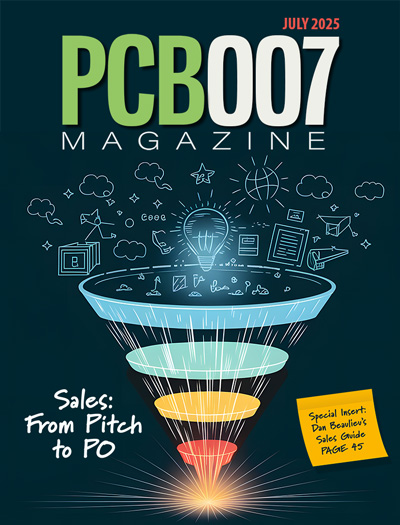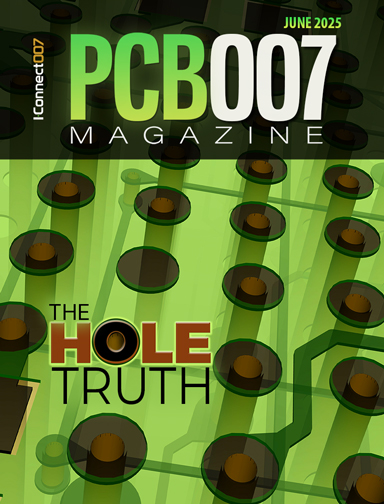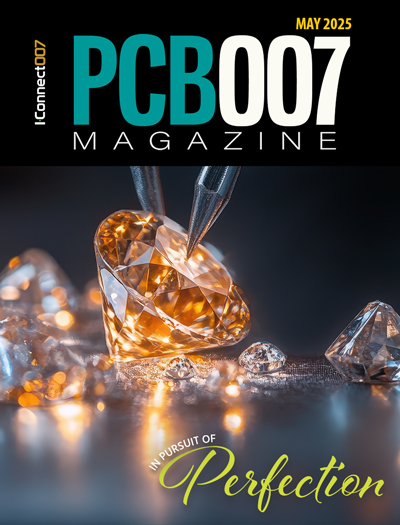-

- News
- Books
Featured Books
- pcb007 Magazine
Latest Issues
Current Issue
Sales: From Pitch to PO
From the first cold call to finally receiving that first purchase order, the July PCB007 Magazine breaks down some critical parts of the sales stack. To up your sales game, read on!

The Hole Truth: Via Integrity in an HDI World
From the drilled hole to registration across multiple sequential lamination cycles, to the quality of your copper plating, via reliability in an HDI world is becoming an ever-greater challenge. This month we look at “The Hole Truth,” from creating the “perfect” via to how you can assure via quality and reliability, the first time, every time.

In Pursuit of Perfection: Defect Reduction
For bare PCB board fabrication, defect reduction is a critical aspect of a company's bottom line profitability. In this issue, we examine how imaging, etching, and plating processes can provide information and insight into reducing defects and increasing yields.
- Articles
- Columns
- Links
- Media kit
||| MENU - pcb007 Magazine
Real Time With... IPC APEX EXPO 2025: Best Student Technical Paper Winner—Attila Rektor
April 10, 2025 | Marcy LaRont, I-Connect007Estimated reading time: 4 minutes
We conducted an audio interview with Attila Rektor, a Ph.D student from Boise State University who won the best technical paper award at IPC APEX EXPO 2025. His paper explores enhancing the conductivity of laser-induced graphene for flexible circuits. The research, funded by SAIC, involved modulating surface energy to enable effective copper plating. This breakthrough has potential applications in flexible printed circuit boards, sensing, and biomedical devices.
TRANSCRIPT:
Marcy LaRont: Hi, this is Marcy LaRont with Real Time with… IPC APEX EXPO, and I am here with Attila Rektor. He is the student winner for the best technical paper at IPC APEX EXPO. He is a Ph.D student out of Boise State. Hi, Attila. Thanks so much for talking to me.
Attila Rektor: Hi. It's good to be here.
LaRont: Congratulations on your award.
Rektor: Thank you.
LaRont: I'm going to say the full title of your paper, because it's quite a mouthful, then I'll ask you a few questions. Your paper is titled, “Flexible Hybrid Electronics Created from a Multi-component System of Electric Copper on Laser-induced Graphene.” Tell me a little bit about your paper and how you came to that topic. I'm assuming it's part of your Ph.D study.
Rektor: Yes. I remember the email. My funding source for a lot of this research is SAIC and the chief scientist there in charge of the research group recommended it over email.
He said, “Hey, I wonder if we can put palladium in the laser-induced graphene and if that would work for plating.” And that was it. It was that casual, just a very simple email: “Hey, would this work?”
LaRont: Sometimes the best topics come out of something like that.
Rektor: That led to about a year’s worth of looking at this and putting things together, and it did work. Very simply, laser-induced graphene is a graphitic material. Then you form it by exposing a laser onto a carbon rich substrate. That's about it. You make something similar to bulk graphite but it has mono-layer regions and multilayer regions of graphene, which has all these very interesting properties.
So, you get fairly good conductivity, but it's not anything like bulk metal. If you want to use this for a circuit application, then it should probably have higher conductivity. So, the entire process has been looking at how can we put down copper or some metal to metalize this and make it conductive enough for a flexible circuit, essentially.
LaRont: And you did.
Rektor: Yes, with a lot of experimentation. We found a process to do that.
LaRont: Was there anything surprising in the course of your studying this?
Rektor: Yes. Technically, the surface energy of laser induced graphene can be tuned between hydrophobic and hydrophilic depending on how you form this material. Palladium is critical for providing the reduction of copper ions in the plating. But if you have the wrong surface energy, regardless of how much palladium you have, it will not plate. We found that we had to modulate the surface energy to get it to plate even with palladium. It was just astounding because the way we did that was the difference between one laser pass and two laser passes. One just absolutely did not coat and one coated very well.
LaRont: How did you modify the surface?
Rektor: As the laser rasters, it forms your pattern that makes the laser induce graphene. But as you laser in an ambient environment, you tend to functionalize the surface. With oxygen, for example, the carbon oxygen bond is very polar, so it becomes more hydrophilic the more that you functionalize it. If you laser over the same pattern multiple times, you can make the pattern more hydrophilic. If that is going into an electrosolution with water as a solvent, you now have a much better interface. The short answer would be that you laser the pattern multiple times, at least twice, in this case.
LaRont: You're studying material science?
Rektor: Yes, that's correct.
LaRont: We sure need great material scientists right now, so that's great to hear. I'm not an engineer, so if this should be obvious, I apologize, but what kind of applications would this process be used in?
Rektor: Very broadly it would be flexible printed circuit boards, but LIG as a candidate material is great for sensing, joule heating, capacitive for energy storage purposes. Biomedical, it finds use. I believe there were LIG based COVID sensors during COVID. More specifically for PCB production, anything that you could really accomplish in a single or maybe two layers as far as circuit design.
In our case, we made just a demo circuit that has switching behavior between two LEDs. It was something easy to visibly see that the circuit is functioning, but I guess you could get as complex as you wanted in that regard.
LaRont: Well, I want to say congratulations again. It's a pretty big deal to be chosen in any of the categories. But I think, as a student, winning best technical paper is pretty impressive. So, Attila, well done, and congratulations again.
Rektor: Thank you. It's a great honor. I’m very grateful.
LaRont: This is Marcy LaRont with Real Time with… IPC APEX EXPO, here with Attila Rektor, the technical paper student winner this year at the IPC show. Thanks for tuning in.
Testimonial
"The I-Connect007 team is outstanding—kind, responsive, and a true marketing partner. Their design team created fresh, eye-catching ads, and their editorial support polished our content to let our brand shine. Thank you all! "
Sweeney Ng - CEE PCBSuggested Items
IEEE Study Shows Thermal Scaling Analysis of Large Hybrid Laser Arrays for Co-Packaged Optics
07/22/2025 | PRNewswireMulti-wavelength light sources are required for optical transceivers to increase data. However, scaling the laser array size increases thermal crosstalk, which may affect laser efficiency and reliability.
indie’s LXM-U Laser Powers Next-Gen Quantum Technologies with Ultra-Low Noise Performance
07/14/2025 | indie Semiconductorindie, an automotive solutions innovator, is rapidly gaining industry adoption in its photonics portfolio, with indie’s latest ultra-low noise LXM-U lasers enabling next-generation quantum applications by delivering industry-leading frequency stability and integration flexibility.
New Podcast Series Launches: Optimize the Interconnect
07/16/2025 | I-Connect007I-Connect007 is excited to announce the debut of Optimize the Interconnect—a new podcast series featuring guest Chris Ryder, senior director of business development at MKS’ ESI. This insightful series explores how MKS’ ESI is rethinking microvia formation for today’s most advanced HDI PCB and substrate designs.
IEEE Study Describes Breakthroughs in Semiconductor Nanolasers for Ultra-Efficient Optical Technologies
06/25/2025 | PRNewswireA new wave of innovation is transforming the future of optical technologies, driven by rapid advancements in semiconductor nanolasers. These advances are essential for future applications such as on-chip optical communication and neuromorphic computing, which require compact, energy-efficient light sources.
Excellon Installs COBRA Hybrid Laser at Innovative Circuits
06/23/2025 | ExcellonExcellon is pleased to announce the successful installation of a second COBRA Hybrid Laser System at Innovative Circuits, located in Alpharetta, Georgia. The Excellon COBRA Hybrid Laser System uniquely combines both UV and CO₂ (IR) laser sources on a single platform—making it ideal for high-density prototype and production printed circuit boards (PCBs).


